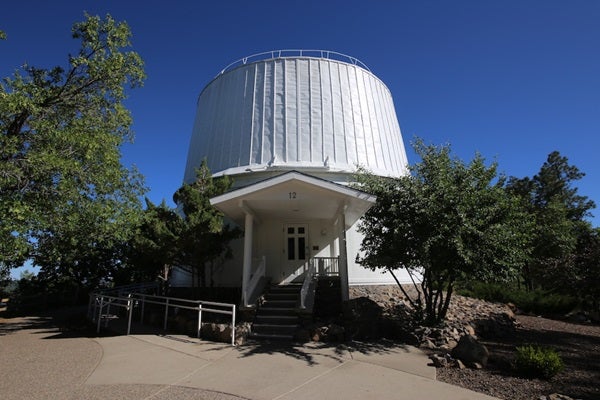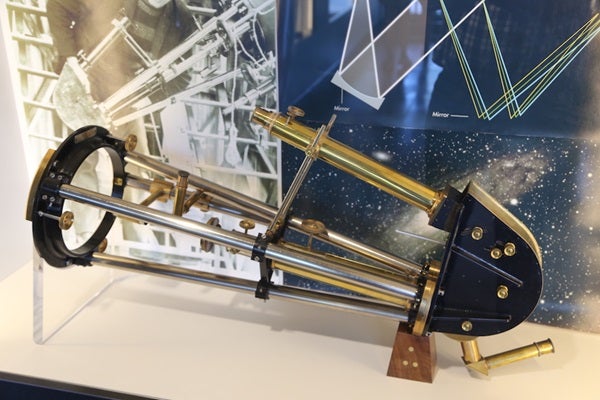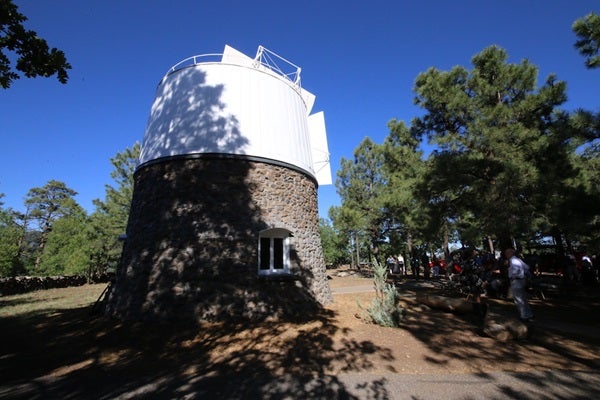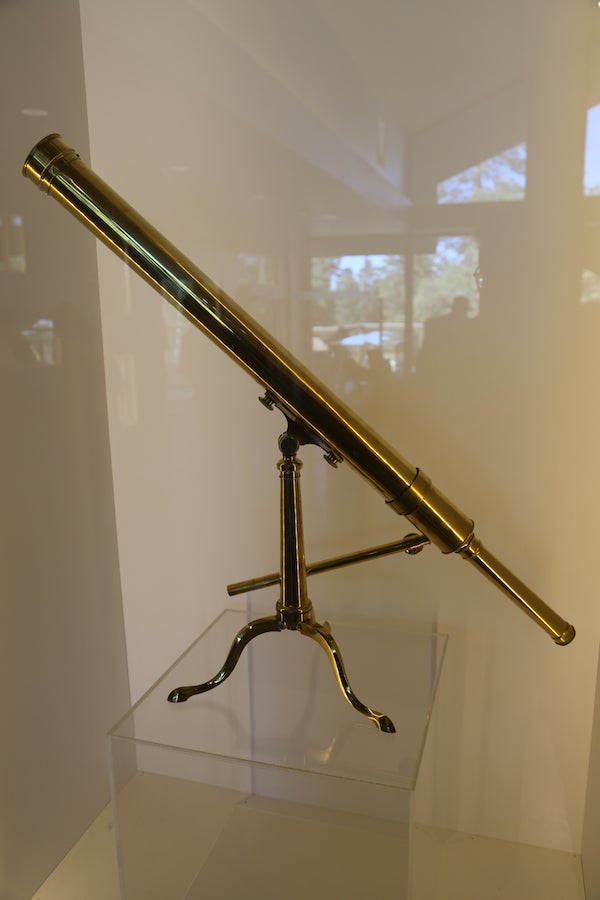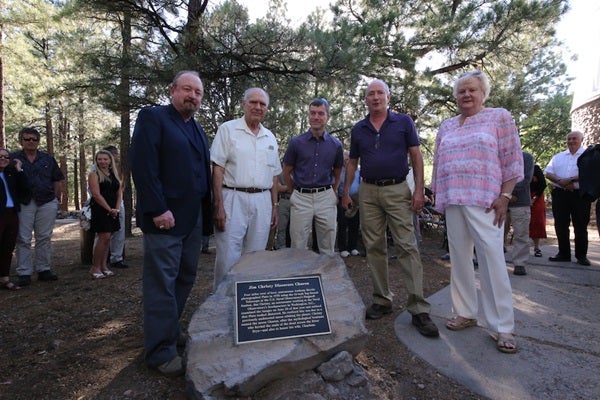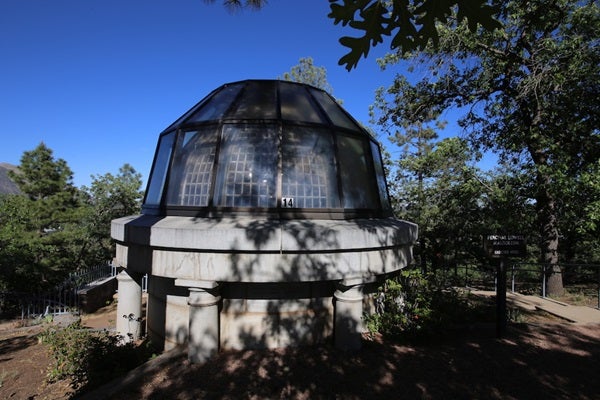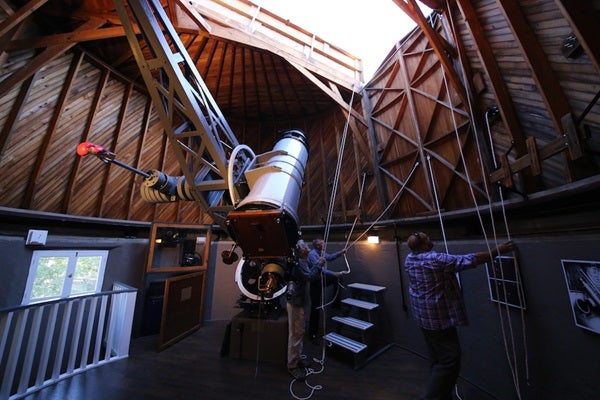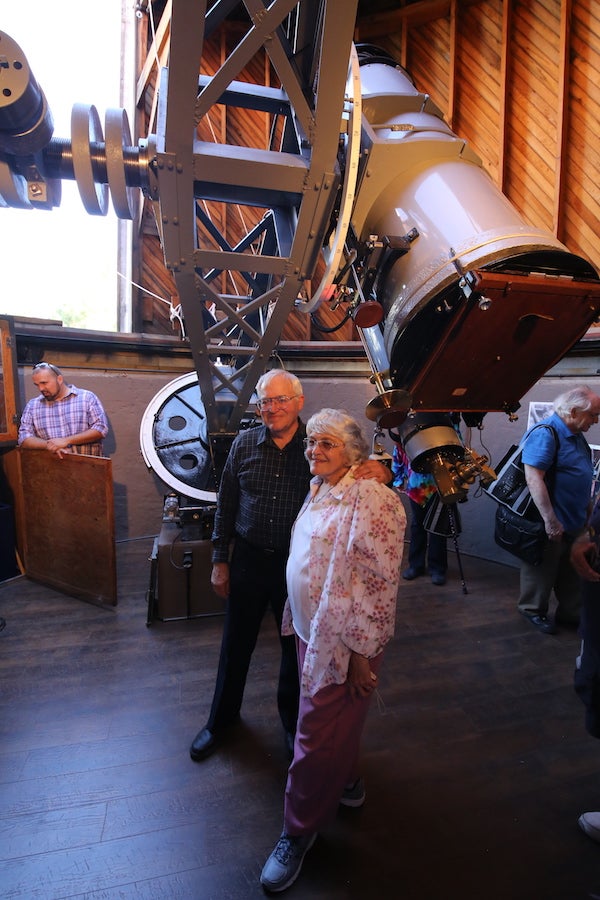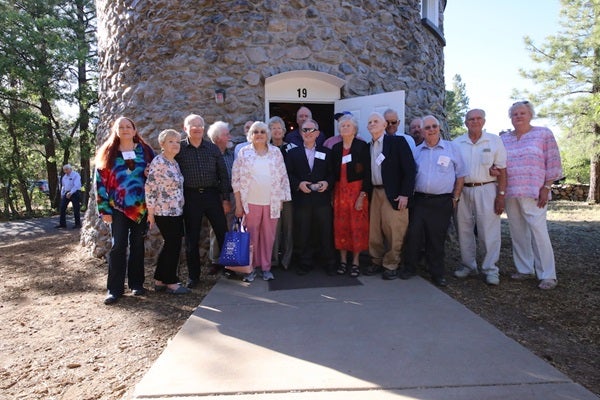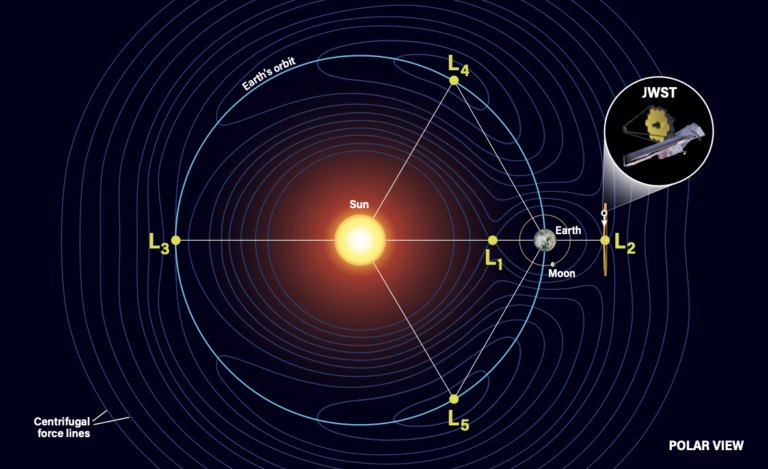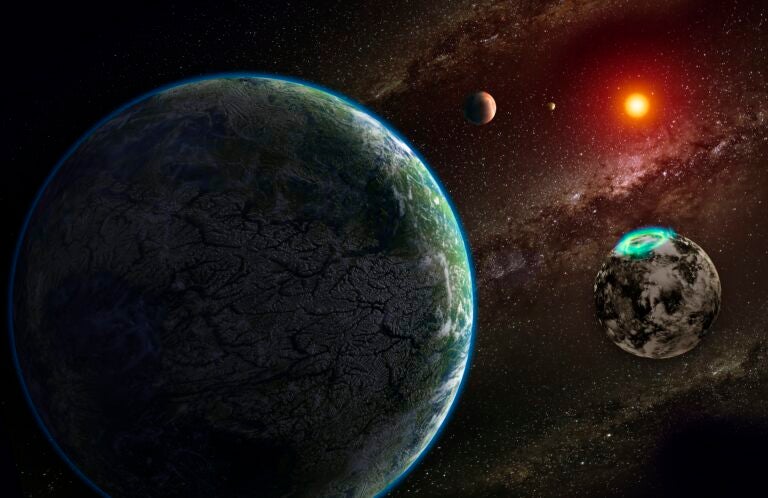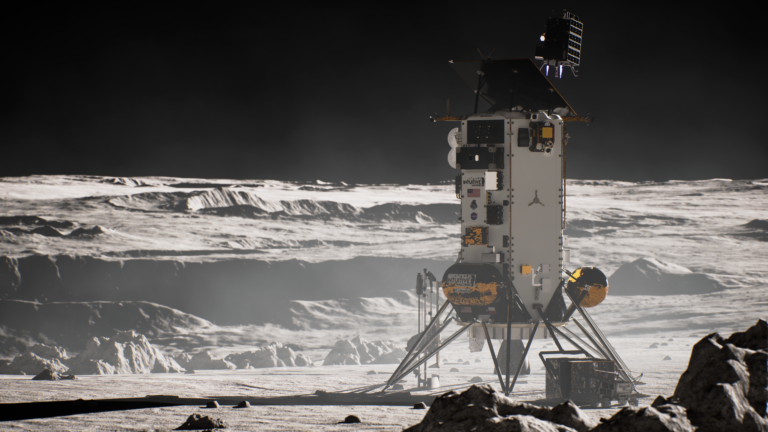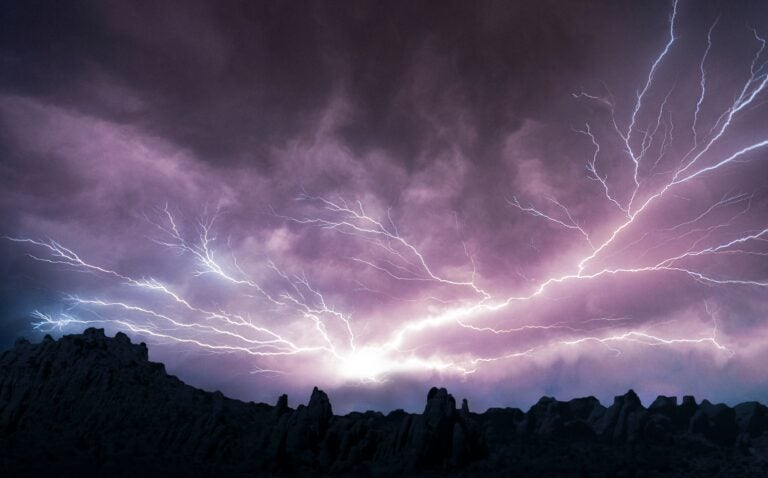And there’s Lowell. I like to call Lowell “America’s observatory” because of its unique combination of astronomical history, important discoveries, a heritage tied to Pluto and Mars, and a vibrant, ongoing, and unique program of current science. It is a place like no other on Earth, within or outside of science. Lowell Observatory is an independent, non-profit organization governed by a sole trustee. This gives the observatory, and the astronomers who work there, incredible freedom in planning and executing their research programs. For anyone interested in astronomy, the exploration of the universe, the history of science, or just how we know what we know as a civilization, a visit to Lowell Observatory is essential.
But these days there’s a lot more going on at Lowell Observatory than normal. The institution is entering a new age, one that will transform it into something well beyond what its founder, Percival Lowell, might have imagined. A multimillion-dollar effort to transform the observatory is being led by Lowell Putnam, the institution’s current trustee, who is also the great-grandnephew of Percival Lowell.
The story of Lowell Observatory begins with Percival Lowell (1855–1916), the observatory’s founder and part of the famous Lowell family of Boston. Wealthy members of Boston’s elite, the Lowell family also included three famous siblings of Percival — the celebrated poet Amy Lowell, the educator Abbott Lawrence Lowell, and the activist and philanthropist Elizabeth Lowell Putnam. The family’s patriarch, Percival Lowle (1571–1665), emigrated to the United States from England in 1639. Other famous members of the family included Union Brig. Gen. Charles Russell Lowell, poet and editor James Russell Lowell, industrialist Francis Cabot Lowell, and John Lowell, judge and delegate to the Congress of the Confederation.
Percival graduated from Harvard University and MIT, and spent his younger days running the family business based in Lowell and Lawrence, Massachusetts. Keenly interested in science from his youth, however, he was especially attracted to the mystery of Mars. Elected a fellow of the American Academy of Arts and Sciences in 1892 because of his books about Japan and Korea, he moved back to the United States the following year. In 1894, he set about establishing his childhood dream, building an observatory dedicated to studying Mars and other phenomena. He was entranced by the features on Mars, and read extensively about the planet’s linear features observed by Italian astronomer Giovanni Schiaparelli, the director of Italy’s Brera Observatory in Milan.
Lowell chose Mars Hill in Flagstaff following a series of site tests, and oversaw the construction of a 24-inch Clark refractor as the observatory‘s primary instrument. Its initial mission was to study Mars. Lowell made many observations of the Red Planet, producing drawings and famously believing that the linear features he observed — the same ones noted by Schiaparelli — could be irrigation canals built by a Martian civilization. Lowell wrote several books about Mars, and continued his fascination with it. The idea that “non-natural features” could exist on Mars lingered in some minds until the 1960s, when the first spacecraft showed they didn’t exist.
Lowell also initiated a widespread and systematic search for “Planet X,” a hypothetical ninth planet believed to lie beyond the orbit of Neptune. A search program begun in 1906 utilized a 5-inch camera. The search continued for years, and by 1928, work on a dedicated telescope for this project commenced. By 1929, work had finished on a 13-inch astrographic telescope, now called the Pluto Telescope or the Pluto Camera. In 1930, the young astronomer who traveled from Kansas to work at Lowell Observatory, Clyde Tombaugh, discovered Pluto as he “blinked” two glass plates made with the telescope and saw its image move relative to the fixed stars. The discovery of Pluto at the observatory permanently fixed Lowell Observatory into the American consciousness. Lowell did not live to see this feat, however, as he passed away in 1916.
The list of other scientific accomplishments at Lowell Observatory is long. Before World War I, starting in 1910, astronomer V.M. Slipher used a special spectrograph to find that many “spiral nebulae” were receding at high velocities, thus discovering the expansion of the universe. This huge cosmological find provided the initial data sets used by Edwin Hubble more than a decade later. Slipher used the same spectrograph to discover gas lurking in the Pleiades star cluster and elsewhere, thus discovering what came to be known as the interstellar medium — the stuff between the stars.
Indeed, the New Horizons mission used Lowell Observatory astronomer Carl Lampland’s plates from 1921 to refine the course of that spacecraft. And the heritage of solar system research continued to be very strong at the observatory. Among other discoveries made at Lowell are the co-discovery of the rings of Uranus, the detection of Pluto’s atmosphere, accurate orbits for Pluto’s moons Nix and Hydra, oxygen in the spectrum of Jupiter’s moon Ganymede, periodic variation in the activity of Comet Halley, and many other feats.
Lowell Observatory is a dream for visitors who marvel at the history of science. Here, today, you can find the 24-inch Clark refractor and its historic dome, which is open for public viewing on most nights, clouds and calm winds permitting. Seeing Mars through this telescope is a chilling experience that connects you very strongly to the history of astronomy. Beside the historic telescope stands the tomb of Percival Lowell himself, and the spirit of “Uncle Percy,” as he is sometimes called, pervades the institution. A short walk uphill leads to the Pluto Telescope and its dome, and both of these instruments have been beautifully and meticulously refurbished over the past several years. They are showpieces to science, and now also showpieces to the eye.
Eyes on the stars
But at Lowell, the past is prologue, as Shakespeare said. The current expansion plans are spectacular, and promise a very different institution a few years from now. The change is already beginning to happen, in fact. In the fall of 2018, the observatory breaks ground on a new project, the Giovale Open Deck Observatory (GODO), which will be arguably the greatest open sky observatory complex of telescopes available to tourists anywhere.
Named in honor of Lowell supporters Ginger and John Giovale, the complex will be built atop Mars Hill, not far from the Pluto telescope, and will consist of a circular observing platform and a massive building with a roll-off roof. The elevated plaza will measure almost 5,000 square feet (465 square meters) and will host multiple telescopes for public viewing, including a 32-inch Dobsonian that will be the largest telescope on the hill. Displays and low-light video viewing on screens will make it possible for groups to see live photons from the telescopes at once. No such facility exists at present. The GODO will be unique to the world of public observing. It is planned to open for visitors in the spring of 2019.
So an ambitious fundraising effort already underway and planned into the future will help to accomplish a whole set of new goals that will bring Lowell Observatory into a new era. The observatory plans to raise millions of dollars to help its entrance into the decades of science education and outreach, and research that will follow.
Other ambitious structural, facility, and building plans are on the drawing board, scheduled for a little further on from the construction of the GODO. They include making a large one-way loop road around the mountain to accommodate the increasing numbers of cars from visitors, a much expanded parking lot, and a huge new building called the Astronomy Discovery Center that will present numerous displays and exhibits of artifacts in an expanded museum setting. The center will also feature a substantial planetarium and theater that can host state of the art shows, as well as lectures by astronomers.
The observatory is loaded with incredible artifacts from the history of astronomy, and some are now on display in the Collections Center. They include Percival Lowell’s famous touring car, “Big Red,” a 1911 Stevens-Duryea Model Y “Big Six”; Lowell’s first telescope; the Slipher spectroscope; and many other pieces of equipment, telescopes, and globes. But numerous other artifacts could be displayed in the expanded space the new Discovery Center would provide, including the famous Pluto “B plate,” one of the two glass plates on which Pluto was discovered — or, for obvious security reasons, a copy. (The other, the “A plate,” is on loan to the Smithsonian Institution.)
The building of a 4-meter telescope
Where did this incredible expansion and sense of drive come from? A generation ago, Lowell’s astronomers and trustee had big ideas. Yes, the institution is deeply steeped in history. Pluto and Mars are tied to the observatory like they are to no other place on Earth. But in order to build a cutting-edge research facility for decades to come, Lowell’s administrators realized they needed a powerful, modern, large telescope. That led to investigations, and eventually partnered Lowell with Discovery Communications. In 2003, former Discovery CEO and founder John Hendricks proposed what would become a $16 million gift to commence the 4.3-meter Discovery Channel Telescope project. Discovery received naming rights to what would become the largest and most sophisticated telescope in northern Arizona.
The expense and complexity of the Discovery Channel Telescope, known as the DCT, completely reworked Lowell and sent the organization into a more modern, more complex, larger era of operations. The telescope is one of the busiest, most modern instruments involved in astronomical research today, and Lowell has formed scientific partnerships for DCT access with Boston University, the University of Maryland, the University of Toledo, Northern Arizona University, Yale University, the University of Texas, and the Korea Astronomy and Space Science Institute (KASI). The DCT saw its first fully operational light in 2015, and has been a workhorse ever since. The telescope stands on a mountaintop at Happy Jack, Arizona, some 40 miles southeast of Flagstaff, at an elevation of 7,740 feet.
In 2017, the DCT operators could claim 282 nights of scheduled science observations. That’s an incredibly productive telescope for astronomers all over, far from just those at Lowell. Several specialized instruments are a key part of current research with the DCT. One such instrument the Immersion Grating Infrared Spectrometer (IGRINS), which is powerful because it provides both a broad spectral reach and high spectral resolution. This instrument is a product of the University of Texas and KASI and will return to DCT in fall 2018 for its third multi-month visit. It is a uniquely powerful tool with which to study the interstellar medium, how stars form, and the early evolution of stars and planetary systems.
Further, the observatory expects to unveil yet another specialized instrument by next summer. The Rapid Infrared Imager Spectrograph (RIMAS), coming from the University of Maryland, will combine imaging and spectrographic capabilities on the DCT. This will enable astronomers to study many astronomical objects in revolutionary ways, including follow-up observations of gamma-ray bursts or star-forming regions where infrared light can penetrate thick clouds of obscuring dust.
These projects and others are planned for the busy DCT. The big telescope is driving much of what Lowell astronomers are doing scientifically, but by no means all of the science activities. And the DCT site at Happy Jack is not the only Lowell research site away from Mars Hill. Some 12 miles (19 kilometers) southwest of Flagstaff stands Anderson Mesa, a landform with an elevation of 7,096 feet (2,163 m). This shelf supports multiple telescopes from both Lowell Observatory and the U.S. Naval Observatory, another major research institution in town. Lowell’s Anderson Mesa Station has existed here since 1959, when two of its major telescopes were placed.
Built in 1931, the 72-inch (1.8m) Perkins Telescope was originally placed at Perkins Observatory in Delaware, Ohio, as a project of Ohio Wesleyan University. The telescope was moved to the better Arizona skies in 1961. Purchased by Lowell in 1998, it has been a workhorse research instrument and is now used exclusively by Boston University for a long-term, infrared survey program. Also atop Anderson Mesa is the John Hall Telescope, a 42-inch (1.1m) telescope installed in 1970.
Other telescopes also exist at Anderson Mesa. The 31-inch (0.8m) telescope of the National Undergraduate Research Observatory was built in 1964 and purchased by Lowell in 1972. Refurbished in 1990, this totally robotic telescope continues to be used for various aspects of planetary and stellar research. Telescopes once stationed at Anderson Mesa but no longer there include the 24-inch (0.6m) LONEOS Schmidt camera used widely for asteroid discovery, among other tasks. And the Pluto Telescope was relocated to Anderson Mesa from 1971 to 1992, before returning to Mars Hill.
But the big news at Anderson Mesa in recent times has come from a different angle. Construction began in 1992 on a telescope that is so modern, it challenges technology and data interpretation. The Navy Precision Optical Interferometer (NPOI) is a joint effort of Lowell, the U.S. Naval Observatory, and the Naval Research Laboratory. The chief scientist of this ambitious effort is Lowell astronomer Gerard van Belle, who oversees a mammoth operation. This interferometric telescope has the largest baselines of any such instrument in the world, making it a stunning step forward scientifically. Interferometers use the combined signals from an array of telescopes to effectively achieve far greater resolution of images than could normally be achieved. The telescope now honors the project’s godfather at the Naval Observatory, Dr. Kenneth Johnston.
This specialized telescope can make measurements of the universe in extremely specialized, high-precision ways. NPOI uses an array of up to six mirrors laid out in a Y-shaped configuration, bringing the six beams of light together in an image assembly building. This creates the ultra-high resolution images. Because of the technique, NPOI can create images of close binary stars that appear to be just a single point of light in the largest conventional telescopes. The instrument is able to record the positions of stars in the sky so accurately that the Naval Observatory uses it as a standard for timekeeping, based on the positions of various stars and positions on Earth and in space. This specialized telescope is still in modes of refinement, and when completely finished will span the distance of four football fields in length.
NPOI is yet another arena in which Lowell finds itself, as with the DCT, catapulted quickly into the future.
With such great history and an amazing array of instrumentation, Lowell has become an extremely active center of astronomical research, in a variety of directions. The coordinated effort to do astronomy at Lowell begins with the facility’s very energetic, expert, and affable director, Jeff Hall. The observatory’s director since 2010, Hall is an astronomer with considerable expertise in solar and stellar science. He runs an active program, along with several colleagues, monitoring solar and stellar activity cycles. Their goal is better understanding the full range of variations Sun-like stars exhibit, lending a more complete view to the possible range of solar variations and the Sun’s influence on Earth’s climate.
Hall is also very active with promoting dark sky activism, talking to groups often about light pollution, and presently chairs the American Astronomical Society’s standing committee on the topic. He is a member of Flagstaff’s leadership group, former president of the governing board of a prep charter school, and sits on the Artistic Advisory Committee for the Flagstaff Symphony Orchestra. He is also an organist at the Episcopal Church of the Epiphany in Flagstaff. With such an active role in the community, beyond his directorship and research interests, Hall sets a very high standard for the institution.
Other astronomers play a multitude of roles. Deputy Director for Science Michael West is a longtime galaxy expert who has played significant roles in a number of institutions. West’s research interests include star clusters, galaxy formation and evolution, clusters of galaxies, and the large-scale structure of the cosmos. He has been director of the Maria Mitchell Observatory, head of science in Chile for the European Southern Observatory, head of science operations at the Gemini South Telescope, and a professor of astronomy at the University of Hawaii. He is also very active in astronomy education and outreach, as well as promotion of dark skies.
George Jacoby, Deputy Director for Technology, is an astronomer whose background includes expertise on planetary nebulae, among other things. Jacoby spent most of his career at the National Optical Astronomy Observatory in Tucson, and conducted a great deal of research at Kitt Peak National Observatory, where he served as director of WIYN Observatory.
The astronomers run the gamut in their specific interests and projects. Ted Dunham is responsible for astronomical instrumentation developed at Lowell. His research centers on stellar occultations by planets in the solar system, utilizing observations made aboard the airborne observatory SOFIA. Dunham, along with Jacoby, plans to retire at the end of 2018 but stay active with the observatory in a reduced role.
Focusing on icy outer solar system objects, Will Grundy uses a wide variety of techniques for investigation. He is involved in projects to discover binary Kuiper Belt objects, determining their orbits and masses, using the Hubble Space Telescope as well as adaptive objects on the Keck and Gemini Telescopes. He is the surface composition team lead for the New Horizons Mission to Pluto and beyond, and an editor of the planetary science journal Icarus.
Jennifer Hanley is interested in the stability of liquids throughout the solar system, with particular focus on Mars, Titan, and Europa. She works in collaboration with the ices laboratory at Northern Arizona University to investigate the properties of liquids at low temperatures and pressures, allowing her to investigate Pluto and Titan. She also researches the stability of water and associated chlorine salts on Mars and Europa.
Stephen Levine is the Discovery Channel Telescope Scientist, an important logistical role for the observatory. He was instrumental in bringing Lowell’s modern instrument from concept to full-on, full-time science operations during its commissioning phase, and now serves as a key technical member of the facility staff. Levine’s primary research interests include large astrometric surveys, numerical simulations of astrophysical disk systems, with a particular focus on the evolution of lopsided disks and irregular galaxies. He is using observations of gravitational microlensing events to understand astrophysical disks.
One of the newer additions to Lowell’s staff is Joe Llama, who focuses on solar systems throughout the Milky Way Galaxy and their potential for habitable planets. He is also actively involved in searching for exoplanetary magnetic fields and understanding how they may shield a planet from overpowering radiation. He also studies how a star‘s activity might prevent us from detecting atmospheres on exoplanets surrounding it.
Phil Massey joined the Lowell staff from the National Optical Astronomy Observatory, where among other things he was the telescope scientist for the famous 4m Mayall Telescope. His current role includes serving as the principal investigator for the Large Monolithic Imager, the principal optical camera on the Discovery Channel Telescope. He is interested in studying massive stars, binary stars, young star clusters, the young stars in nearby galaxies to understand how the most luminous stars evolve.
Focusing on the solar system, Michael Mommert is chiefly absorbed with studying the physical properties of asteroids and comets. He observes these objects in wavelengths from optical to the near-infrared, and discovers colors that pertain to compositions. He studies masses, reflectivities, rotational properties, and shapes of these objects.
Also highly interested in small bodies in the solar system is Nick Moskovitz, who studies asteroids using observations and modeling. His work collects data that relate to such diverse topics as the origin of small bodies and potential exploration of these objects by spacecraft. Moskovitz wants to understand the link between asteroids and meteorites, understanding of asteroid impactors, and geologic processes in the early history of the solar system.
The energetic astronomer Lisa Prato is a stellar and planetary astronomer who focuses mostly on three specialized areas: measuring accurate mass ratios in binary star systems lying in young star-forming regions, studying the properties of stars and their planet-forming disks in young binary systems, and surveying radial velocities for the youngest planets forming around low-mass stars. She maintains catalogs of binary stars and stellar spectra, and is also highly active with astronomical outreach programs.
A veteran of Lowell’s staff, Dave Schleicher is an expert on comets — specifically the physical properties, chemical composition, and evolutionary behavior of comets. He uses both observation and theoretical modeling to push forward the understanding of comets, and was a co-discoverer of the periodic variability of Comet Halley, the most famous comet of all time.
The previously mentioned Gerard van Belle, who heads up the effort at NPOI, is an expert on the fundamental properties of stars — their masses, sizes, and temperatures. He is interested in understanding the internal structures and evolution of stars so that astronomers can understand the numerous planets being discovered orbiting nearby stars.
Also a veteran of Lowell’s staff is Larry Wasserman, who studies solar system bodies using occultations. His predictions, observations, and resulting data from these events has produced a huge amount of knowledge of the properties of solar system bodies. He is also involved in studying binary stars with the Hubble Space Telescope.
Such a staff gives Lowell a huge degree of flexibility in the production of new information about the universe. And the era into which the observatory is now entering will be perhaps the most exciting and revolutionary one since the founding of the institution itself. I’ve long been a fan of this place, and have been privileged to be able to hang around Mars Hill and some of its science, off and on, for many years. When I was a youngster, having just started publishing Deep Sky magazine and joining the staff of Astronomy, I traveled to Flagstaff a number of times. My astronomer-writer friends included Brian Skiff, known to most astronomy enthusiasts as a walking database of astronomical knowledge.
Brian took me under his wing many years ago, contributed stories to my publications, and allowed me to “work” with him as an assistant at Lowell, taking photometric data for a span of 10 days, in 1985. The experience ended up as a story in Deep Sky magazine. I can still vividly remember the strong sense of history I soaked in at Lowell. After nearly all-night sessions of taking data, I recall once going back into the observatory’s buildings and falling asleep on a couch, over which was affixed a famous portrait of Percival Lowell. Waking up a time later and seeing “Uncle Percy’s” eyes gazing down at you left a powerful impression.
Another friend of the Arizona days in the 1980s was David Levy, a contributor to Deep Sky and Astronomy and famous as the great comet discoverer who later helped find the comet that crashed into Jupiter. Hanging around Brian and David brought me into contact with some amazing personalities associated with Lowell: Clyde Tombaugh, who discovered Pluto in 1930 and was then still around, in his old age; Gene and Carolyn Shoemaker, the great geologist and astronomer husband and wife; then-observatory directors Jay Gallagher and Bob Millis. And many others. It seemed like a magical time for astronomy in Flagstaff. My old friend Brian is still at the observatory, still taking lots of data, still an amazing expert and walking encyclopedia. Some things never change — thank goodness.
And now, suddenly, with the creation of a 4-meter, world-class telescope and visitation at an all-time high, straining the mountain’s facilities, Lowell is entering a new age altogether.
In June of this year, I was privileged to be at Lowell once again, attending the annual meeting of the observatory’s board of advisors, asked to join this group by Lowell Putnam. Having been to just two of these meetings, I can’t tell you how exciting the future looks for Lowell. Discussing the huge plans for expansion and science outreach with Lowell Putnam, with Jeff Hall, with Michael West, and others, really crystallizes a vision for a place completely unlike any other science-minded spot on the planet.
This year‘s Lowell gathering was magical, as we celebrated the rededication of the Pluto Telescope with members of astronomy’s royal families attached to the observatory: Lowells, Putnams, Sykes (the brothers who built the Clark and Pluto domes), Tombaughs, Sliphers, and Christys were there for the ceremony. In 1978, across town at the U.S. Naval Observatory, Jim Christy discovered Pluto’s moon Charon, named for his wife Charlene. Both Jim and Charlene Christy were on hand 40 years after the discovery, to help with the celebration. Thanks to the graciousness of the observatory staff, I was able to once again stay in the apartment in which Clyde Tombaugh lived when he discovered Pluto in 1930. The sense of history there was palpable: I could almost hear Clyde delivering his many rapid-fire puns once again.
The future of Lowell begins this fall with the groundbreaking of the Giovale Open Deck Observatory. The ambitious program that follows, with a greatly expanded visitor center, museum spaces, logistics for handling far larger crowds on Mars Hill, dark sky planetarium, and much, much more, will follow. It strains the imagination that Percival Lowell could have imagined the explosive growth and science leadership that seems destined for this institution. America’s observatory is about to take on an entirely new role, and it will be a very exciting ride to watch the process unfold.

